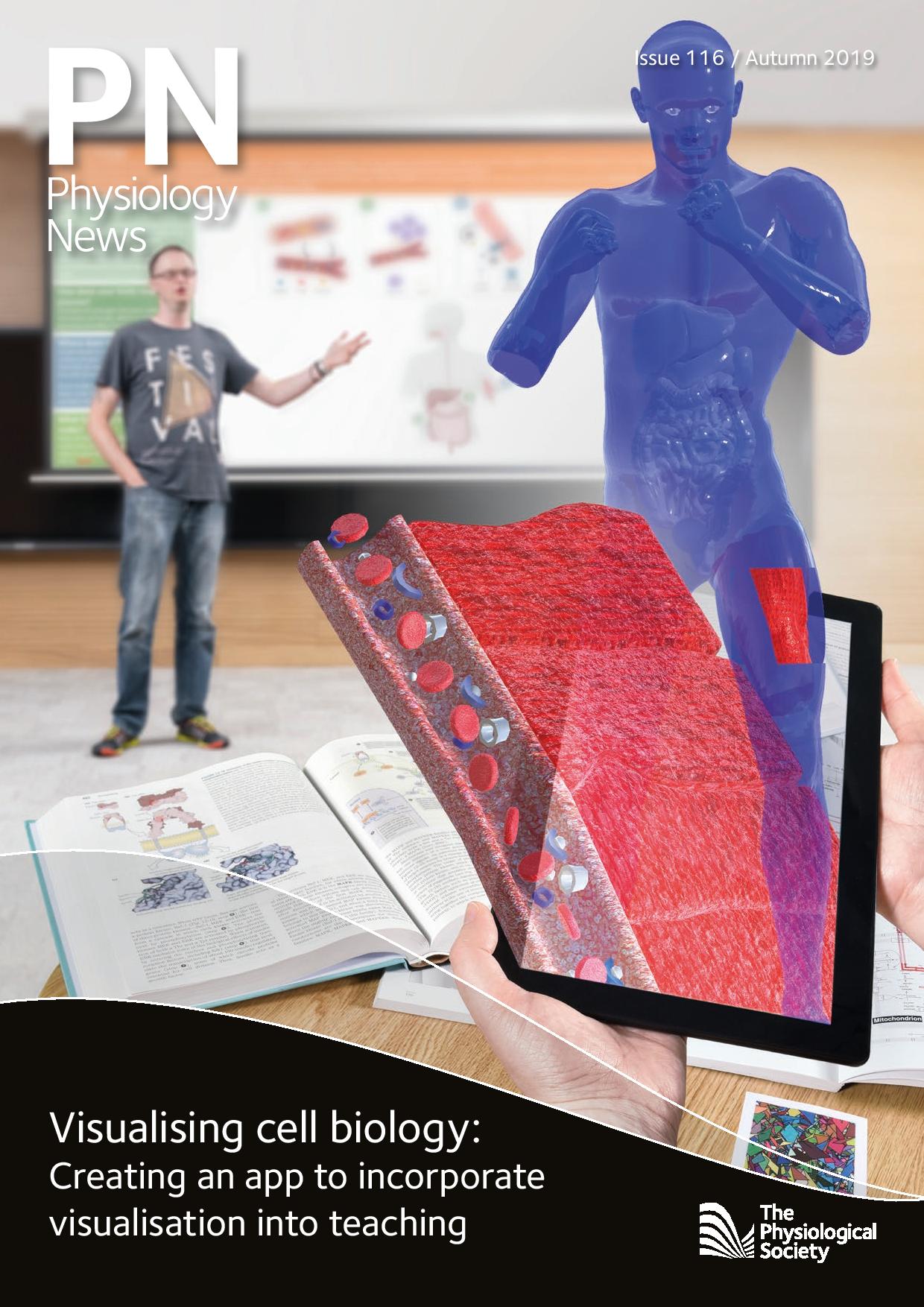
Physiology News Magazine
Flipping physiology
Can we teach physiology in a different way? A traditionalist tries out some new tricks
Features
Flipping physiology
Can we teach physiology in a different way? A traditionalist tries out some new tricks
Features
Matthew J Mason, Department of Physiology, Development & Neuroscience, University of Cambridge, UK
Angela M Gayton, School of Critical Studies, University of Glasgow, UK
https://doi.org/10.36866/pn.116.31
Matt Mason has had a central role in teaching physiology to undergraduates in Cambridge for over 15 years. The article is written in the first person, from his perspective. Angela Gayton, formerly of the Faculty of Education in Cambridge, is now a lecturer in Applied Linguistics and Education at the University of Glasgow. She is supporting Matt’s investigation of students’ reactions to the teaching approach discussed here.
Traditional lectures worked for me when I was an undergraduate. Like most academics reading this article, I did well at university and progressed within that system. I now put a lot of effort into producing similar lectures, and generally get very good feedback. However, when discussing physiological topics with my students afterwards, and when marking their essays, I am often concerned to note a misunderstanding of concepts which I was sure I had explained very clearly.
This must be a common experience for lecturers. When Harvard physicist Eric Mazur found that his students struggled to apply the concepts he had taught to new scenarios, he began using “flipped-classroom” approaches, which resulted in marked improvement (Mazur, 2009). In traditional teaching, the lecturer presents information which is dutifully noted by the students, who may or may not explore this further outside of the lecture theatre. This can too easily degenerate into rote learning, and only superficial understanding. The idea behind flipped-classroom teaching is that the core material is presented outside the lecture theatre for the students to assimilate on their own: the lecture session is then used to explore and strengthen understanding through questions and challenges, often performed in groups (Advance HE, 2017). This has been found to augment peer interaction and improve student motivation (Zainuddin and Perera, 2019). Flipped-classroom methods have been used in physiology teaching elsewhere (Street et al., 2015; Entezari and Javdan, 2016; Rae and O’Malley, 2017), but never in our large-cohort, introductory physiology course.
I tend to be sceptical about new educational practices, but Mazur was a lecturer whose cohort of students was very similar to my own. Might an approach which works in Cambridge, Massachusetts also improve teaching in Cambridge, England? An opportunity to put this to the test presented itself when I was asked to give three lectures about nutrient acquisition to 187 first-year biology undergraduates, as a sabbatical replacement.

Implementation
I uploaded the material from last year’s lecture course, only slightly altered, onto the students’ virtual learning environment, and asked them to read it in advance of the three presentations. In the presentations themselves, students were asked to form groups of 4 – 6, each of which was given a Turning Technologies ResponseCard RF “clicker”.
The format I followed was to ask a question which the students would work in groups to solve, and then I would go through the answer. Questions took four general forms:
Multiple choice. The groups were given a few minutes to select an answer using their clickers. The range of answers was presented on-screen immediately afterwards as a bar-chart, in which the performance of individual groups remained hidden (Fig. 1). As well as helping the students to see where their understanding might be deficient, the ability to get real-time feedback from the class as a whole allowed me to move on quickly when the class was comfortable with a particular topic, or spend more time explaining when there was some uncertainty.
Calculation questions. The groups were asked to perform calculations, for example “What rise in [K+] would be expected if all the potassium in five bananas were dumped into the extracellular fluid?”. This particular question led to a follow-up calculation about the expected effects of this on resting membrane potentials, which in turn led to a discussion of what the body would have to do to render banana consumption safer.
Diagram completion. Groups were asked to sketch out a cell diagram, showing the transporters responsible for sodium chloride secretion by a salivary acinar cell. After their first attempt, I showed them how they might work this out logically, and later in the presentation I asked them to perform a similar exercise on a different cell type, to see if they had mastered the concepts.
Open-ended discussion. Groups were invited to consider how they might structure different parts of an essay comparing human and ruminant physiology. For example, how do we get away from the limp, default introductory sentence of “In this essay I shall [insert essay title here]”? What does the reader really need to know? I suggested ideas afterwards, while making it clear that there is no single correct answer to such questions.

Student Feedback
Would Cambridge undergraduates, used to a traditional lecture format, accept the flipped-classroom approach? Numerical results from the questionnaire at the end showed that they collectively felt that they had learned more than they would have from a traditional lecture course (mean score 3.55, where 1 indicated “much less”, 3 “about the same” and 5 “much more”; n = 121 students), and had a deeper understanding of the material (mean score 3.50; n = 123). Our students also felt that this flipped-classroom course, with its emphasis on getting them to answer questions for themselves and think more about essay structure, helped them to prepare better for exams (mean score 3.63; n = 120).
Interestingly, our students did not seem to regard flipped-classroom teaching as superfluous despite having weekly “supervisions”, in which lecture topics and associated problems are discussed in small groups led by academics.
Some representative student comments about the benefits of the flipped classroom approach:
“I feel more confident with this series and have a clearer understanding, rather than just remembering the process”
“The interactive nature of the lectures helped me to think through and understand the material used in the lectures better”
“It’s a different flavour from what we get usually; it’s definitely more exciting”.
Before plunging into flipped-classroom teaching it is important to consider some cautionary points, however, including the following:
While most students said that they were able to prepare for these sessions adequately, one possible consequence of delivering a higher proportion of lectures in this format is that students might find it more difficult to allocate the necessary preparation time.
This form of teaching might not suit conceptually difficult topics such as neuroscience, which would be harder for students to assimilate on their own. What came out strongly from the follow-up interviews was that students saw this approach as a useful complement to the traditional format, rather than a replacement.
Our traditional lecture theatre, with tiered seating, was not conducive to group discussions among students.
Going forward
Although a little nervous in advance about what reactions I would get from students and colleagues, I genuinely enjoyed giving these flipped-classroom presentations. There was a buzz in the lecture theatre which one does not get in a traditional session, with periodic cheering as groups got answers right. Concerns about whether students would prepare sufficiently in advance, and whether interactive teaching in supervisions renders flipped classrooms redundant, proved not to be justified: the student response was more positive and far less polarised than I had anticipated. Whether this approach translates into improved exam performance requires careful analysis, but even if not, the enhanced levels of energy and interest among the students made the exercise more than worthwhile.
Restructuring existing lectures is a lot of work but there is much to be said for flipped-classroom teaching, perhaps especially in end-of-course recaps when students are flagging. This is certainly something that I will be doing again – and I will work on converting the other sceptics out there!
Acknowledgements
We thank Andrew Murray for letting us use his lecture material, Matthew Moss and Turning Technologies for granting us a temporary license to use their software, and Darerca Owen and the Department of Biochemistry for the loan of the clickers. Many thanks also to the students for taking the time to provide such extensive and constructive feedback!
References
Advance HE (2017). Flipped learning. [Online] Available at: https://www.heacademy.ac.uk/knowledge-hub/flipped-learning-0
Entezari M, Javdan M (2016). Active learning and flipped classroom, hand in hand approach to improve students learning in human anatomy and physiology. International Journal of Higher Education 5, 222–231.
Mazur E (2009). Farewell, lecture? Science 323, 50–51.
Rae MG, O’Malley D (2017). Student attitudes towards semi-flipped classroom teaching in a pre-clinical graduate entry to medicine Physiology module. Research in Medical Education DOI: https://doi.org/10.15694/mep.2017.000009
Street SE et al. (2015). The flipped classroom improved medical student performance and satisfaction in a pre-clinical physiology course. Medical Science Educator 25, 35–43.
Zainuddin Z, Perera CJ (2019). Exploring students’ competence, autonomy and relatedness in the flipped classroom pedagogical model. Journal of Further and Higher Education 43, 115–126.
